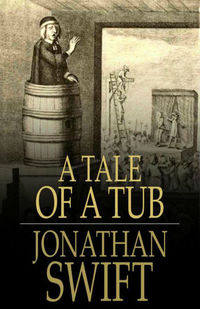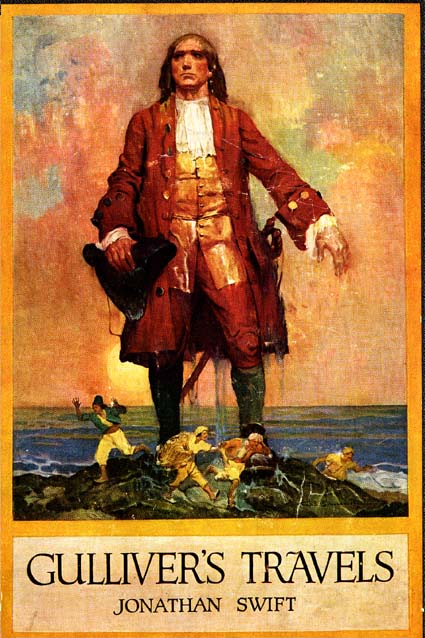Major prose works
Swift’s first major prose work, A Tale of a Tub, demonstrates many of the themes and stylistic techniques he would employ in his later work. It is at once wildly playful and funny while being pointed and harshly critical of its  targets. In its main thread, the Tale recounts the exploits of three sons, representing the main threads of Christianity, who receive a bequest from their father of a coat each, with the added instructions to make no alterations whatsoever. However, the sons soon find that their coats have fallen out of current fashion, and begin to look for loopholes in their father’s will that will let them make the needed alterations. As each finds his own means of getting around their father’s admonition, they struggle with each other for power and dominance. Inserted into this story, in alternating chapters, the narrator includes a series of whimsical “digressions” on various subjects.
targets. In its main thread, the Tale recounts the exploits of three sons, representing the main threads of Christianity, who receive a bequest from their father of a coat each, with the added instructions to make no alterations whatsoever. However, the sons soon find that their coats have fallen out of current fashion, and begin to look for loopholes in their father’s will that will let them make the needed alterations. As each finds his own means of getting around their father’s admonition, they struggle with each other for power and dominance. Inserted into this story, in alternating chapters, the narrator includes a series of whimsical “digressions” on various subjects.
 Drapier’s Letters (1724) was a series of pamphlets against the monopoly granted by the English government to William Wood to provide the Irish with copper coinage. It was widely believed that Wood would need to flood Ireland with debased coinage in order to make a profit. In these “letters” Swift posed as a shop-keeper—a draper—to criticise the plan. Swift’s writing was so effective in undermining opinion in the project that a reward was offered by the government to anyone disclosing the true identity of the author. Though hardly a secret (on returning to Dublin after one of his trips to England, Swift was greeted with a banner, “Welcome Home, Drapier”) no one turned Swift in, although there was an unsuccessful attempt to prosecute the publisher Harding.[27] The government eventually resorted to hiring none other than Sir Isaac Newton to certify the soundness of Wood’s coinage to counter Swift’s accusations. In “Verses on the Death of Dr. Swift” (1739) Swift recalled this as one of his best achievements.
Drapier’s Letters (1724) was a series of pamphlets against the monopoly granted by the English government to William Wood to provide the Irish with copper coinage. It was widely believed that Wood would need to flood Ireland with debased coinage in order to make a profit. In these “letters” Swift posed as a shop-keeper—a draper—to criticise the plan. Swift’s writing was so effective in undermining opinion in the project that a reward was offered by the government to anyone disclosing the true identity of the author. Though hardly a secret (on returning to Dublin after one of his trips to England, Swift was greeted with a banner, “Welcome Home, Drapier”) no one turned Swift in, although there was an unsuccessful attempt to prosecute the publisher Harding.[27] The government eventually resorted to hiring none other than Sir Isaac Newton to certify the soundness of Wood’s coinage to counter Swift’s accusations. In “Verses on the Death of Dr. Swift” (1739) Swift recalled this as one of his best achievements.
Gulliver’s Travels, a large portion of which Swift wrote at Woodbroo k House in County Laois, was published in 1726. It is regarded as his masterpiece. As with his other writings, the Travels was published under a pseudonym, the fictional Lemuel Gulliver, a ship’s surgeon and later a sea captain. Some of the correspondence between printer Benj. Motte and Gulliver’s also-fictional cousin negotiating the book’s publication has survived. Though it has often been mistakenly thought of and published in bowdlerised form as a children’s book, it is a great and sophisticated satire of human nature based on Swift’s experience of his times. Gulliver’s Travels is an anatomy of human nature, a sardonic looking-glass, often criticised for its apparent misanthropy. It asks its readers to refute it, to deny that it has adequately characterised human nature and society. Each of the four books—recounting four voyages to mostly fictional exotic lands—has a different theme, but all are attempts to deflate human pride. Critics hail the work as a satiric reflection on the shortcomings of Enlightenment thought.
k House in County Laois, was published in 1726. It is regarded as his masterpiece. As with his other writings, the Travels was published under a pseudonym, the fictional Lemuel Gulliver, a ship’s surgeon and later a sea captain. Some of the correspondence between printer Benj. Motte and Gulliver’s also-fictional cousin negotiating the book’s publication has survived. Though it has often been mistakenly thought of and published in bowdlerised form as a children’s book, it is a great and sophisticated satire of human nature based on Swift’s experience of his times. Gulliver’s Travels is an anatomy of human nature, a sardonic looking-glass, often criticised for its apparent misanthropy. It asks its readers to refute it, to deny that it has adequately characterised human nature and society. Each of the four books—recounting four voyages to mostly fictional exotic lands—has a different theme, but all are attempts to deflate human pride. Critics hail the work as a satiric reflection on the shortcomings of Enlightenment thought.
In 1729, Swift published A Modest Proposal for Preventing the Children of Poor People in Ireland Being a Burden on Their Parents or Country, and for Making Them Beneficial to the Publick, a satire in which the narrator, with intentionally grotesque arguments, recommends that Ireland’s poor escape their poverty by selling their children as food to the rich: “I have been assured by a very knowing American of my acquaintance in London, that a young healthy child well nursed is at a year old a most delicious nourishing and wholesome food…” Following the satirical form, he introduces the reforms he is actually suggesting by deriding them:
